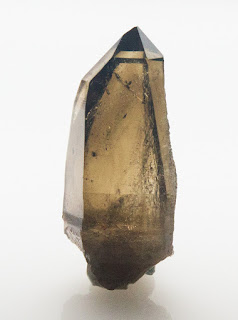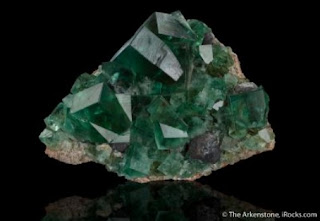Find gemstones in the UK
How and where to find gemstones in the UK
The United Kingdom is a densely populated country that encompasses a small area of approximately 243,000 square kilometers. The UK includes England, Scotland, Northern Ireland and Wales.

The most of the gemstone materials of the UK have been found in Scotland. In fact, even a diamond was found in Northern Scotland in the 1870s by Scottish mineralogist, Professor M F Heddle. Other gemstone materials that have been discovered in Scotland include sapphire that was found on the Isle of Harris, but a protection order prohibits its removal. Small amounts of ruby and beryl (including aquamarine) have also been found in Scotland. There is a place in Fife known as "Ruby Bay", but it is garnet, rather than ruby that is found here. Larger amounts of "blue hole agate", amethyst and smoky quartz were also found in Scotland, and some red and yellow jasper. Zircon has also been found in Scotland.
Before the Scottish diamond was found, in 1816 1813, a diamond was discovered in the Colebrooke River of County Fermanagh, Northern Ireland. Many years later, in 1996, a Canadian company investigated areas of County Tyrone and County Fermanagh. Their exploration suggested that there may be untapped potential. Gemstone quality ruby, sapphire, aquamarine, opal, hematite, calcite and quartz have also been discovered in Northern Ireland. County Tyrone in Northern Ireland is also home to one of the UK's last remaining gold mines.
Wales has also been known as an important source of gold, rather than gemstones in the UK, especially in Roman Britain. Dolaucothi is the first such Roman gold mine that is now a museum. Welsh gold is highly sought after and is the material of choice for gold wedding bands worn by the British Royal Family. With regard to gemstones, quartz, but not many other well-known gemstone materials have been found in areas of Wales.
With regard to England, several gemstone materials have been found. In the North of England, on the Isle of Man and also on the north-eastern coast of England, agate has been found. Also found on the east coast, especially in Whitby, Yorkshire, is jet, which was popular in the 19th century when mourning jewelry was fashionable. Jet is made of fossilized wood and is no longer popular since other black gems have superior gem qualities such as durability. Further down the east coast of England and in the Isle of Wight in the south, amber has been found. Some of this has a rich color that was caused by forest fires in the Cretaceous period, it is sometimes known as "Hastings firestorm amber".
The middle of England is most famous for fluorite. The best-known source for fluorite is Derbyshire, the source of highly regarded "blue John" fluorite, which occurs in purple to blue and yellow to white bands. This is also known as "Derbyshire Spar" or "Derbyshire Blue John". This fluorite was popular during the 1800s when it was sent all over the world.
The two south-western counties known as Devon and Cornwall have seen some interesting gemstone discoveries, such as topaz, tourmaline, beryl, fluorite and amethyst. Cassiterite, which is tin ore, was also mined from this area and is said to have been mined since the Bronze Age. Other metals such as silver and copper were mined here too.
Although the UK is a small place, some unique and interesting materials have been unearthed from its mountains, valleys and shores. Perhaps there are more hidden treasures in the UK, just waiting to be discovered.
Gemstones in the UK
Agate

Reminiscent of Scottish wild lakes and the high rugged mountains of Scotland. Much of Scottish agate was formed by volcanic eruptions, with the yolk forming within the silica-rich gas bubbles of the cooling lava.
The most well-known places to find authentic Scottish Agate is the Blue Hole in the Usan and Lunan Bay.
Amber

One of the most revered gemstones, Amber, specifically Baltic Amber can be found on the “Amber Coast” of Norfolk and Suffolk, between Felixstowe and Southwold. Little globules of orange, Baltic Amber is sought after for both its rarity and its healing properties.
Amber is actually fossilised tree sap, which would have been trapped within the ancient Baltic forest (now all underwater in the Baltic sea). Melting glaciers from the last ice age bring these little gems to the surface, which is why they make their way to our shores.
What is incredibly fascinating is that Amber can even have fossilised critters inside, which is very illuminating as to what kind of species lived millions of years ago.

They say that the best time to go searching for Amber is after a storm, as rough seas shake up the seabed and mover the amber towards the shore. However, the bright and fiery glow that we associate with Amber is actually when the stone is polished. Rough amber is actually a dark rusty brown colour, which is why it can be easily overlooked.
Blue John Fluorite

Another popular gemstone found in the uk, Blue John Fluorite is native to the Blue John Cavern in Derbyshire. So much so that it is also known as Derbyshire Spar! This type of mineral is distinguishable by its bands of blue and yellow, and it is one of the few gemstones that can ONLY be found in the UK!
It remains one of the few gemstones found in the UK, and it is still mined on a small scale today.
Cairngorm Quartz

Another native Scottish gemstone, Cairngorm Quartz is a variety of smokey Quartz exclusively found in the Cairngorm mountains of Scotland. A very desirable variety of Quartz, Cairngorm Quartz is actually considered to be Scotland’s national gem.
This type of Quartz gem is noticeable for its signature slightly yellow colour, due to a small mount of ferric oxide within its structure. ‘Invercauld cairngorm’, is a variety crystal of smoky quartz. Cairngorm Quartz was widely used in Scottish and English jewellery, embellishing weapons, kilt pins, necklaces, earrings and brooches. For some time, Cairngorm Quartz was known as the Scottish Topaz, a testament to its rarity and signature nature.
These miners of Cairngorm would sometimes discover other precious gemstones such as beryl and topaz.
The largest known cairngorm crystal is a 23.6 kg (52 lb) specimen kept at Braemar Castle.
About The Cairngorms
The Cairngorms are the most extensive area of high mountain terrain in Britain. The area has given its name to gem quality smoky quartz, and has also produced spectacular specimens of beryl and topaz.
The Cairngorm Granite lies at the heart of our story. This tough igneous rock is highly resistant to erosion and forms the dissected highland plateau which is the Cairngorms. The distinctive shape of the mountains owes its appearance to the properties and distribution of this rock, and the minerals which occur in it are directly related to its geological origin and history. Within the granite occur cavities, and veins or pockets of pegmatite which contain the gem minerals. These are yellow, smoky or dark cairngorm quartz; yellow-green or blue beryl; and colourless to pale blue topaz.
Jet

Jet was one of the most sought after materials in the 19th century for Victorian mourning jewellery. Specifically, Whitby Jet. Similarly to Amber, Jet is actually fossilised tree wood that is washed up on the shores of Whitby in England.
Formed into a coal-like structure from millions of years of pressure, Jet’s inherently dark colour has etymologically earned itself the originating influence behind “jet black”. The Jet found in Whitby formed over 181 million years ago during the Early Jurassic period. Whilst it's still incredibly rare to find today, W.Hammond, a jeweller in Whitby, is completely devoted to creating true Whitby Jet jewellery today. Whitby beach in Yorkshire is world famous for its jet which was popular in Queen Victoria’s reign. True Victorian Whitby Jet is even rarer to come by, and it is very expensive.
Bristol Diamonds

Whilst there are a few regional varieties of gemstones, have you ever heard of Bristol Diamonds? Not to be confused with the glittering highly prized precious gemstone, “Bristol Diamonds” are actually a type of Quartz that is found in the Avon Gorge caves. These Quartz gems were sought after as a novelty gemstone in the 18th and 19th century, as many persons visited the Hotwells spa (marketed to have rivalled the towns of Bath and Cheltenham).
The “Bristol Diamonds” as they were colloqually known in the 18th and 19th century were actually called Diamonds in the 1586 Topographical survey by William Camden. In fact, he described them as the following: “for in bright and transparent colour, they match the Indian Diaments, if they passe them not; in hardness onely they are inferior to them.”
But what about real diamonds, have they ever been found in England?Diamond

Yes that’s right even diamond has been found in the United Kingdom, admittedly only a very very small amount. In 1813 ‘The Brookeborough’ diamond was discovered in a stream in Co Fermanagh.
In the 1870s teacher M. F. Heddle of St Andrews University discovered a small diamond 5km north of Ben Hope in Scotland.
Recently, some mining companies are carrying out studies and prospecting of samples to see if it is feasible to extract diamonds in England.
See who these companies are in the links at the end of this article.
Other minerals found in England
There include rare and common minerals such as chalcocite, arsenopyrite, calcite, apatite, liroconite, wavellite, botallackite, cerussite, hematite, barite, boracite, pyromorphite, pyrrhotite, scheelite, linarite, mimetite, turquoise, copper, witherite, chalcocite, galena, and others.
See more Mineral and gemstones in UK:
Gold and Gemstones prospecting UK:
Welsh Gold
Although not officially a gemstone, we couldn’t NOT include Welsh Gold in this list of gemstones found in the UK. Welsh Gold is one of the rarest and most sought after types of Gold in the world. Not to mention, it is a type of Gold that many of the Royal Families engagement and wedding rings have been crafted from, including Queen Elizabeth II, Princess Diana, Kate Middleton and Meghan Markle.
Welsh Gold is the first known mined Gold in the UK, dating back to the Bronze Age in Dolau Cothin Wales. Welsh Gold was in regular use until 1938, today only surviving in small increments with a small yield. For instance, in the late 1990s it would cost over £1000 an ounce to extract, and the value of Welsh Gold today is estimated to be up to 30,000 times more than standard Gold. You can still pan for gold in the nearby river Cothi.
Where to find and gold prospecting in England:
Free E-BOOK about England's minerals
For more information about minerals from England, you can read the free e-book covering the Lindsay Greenbank Collection of Classic Minerals of Northern England.
The Lindsay Greenbank Collection Book CoverWhile many Americans are unfamiliar with these British mineral localities, the Lindsay Greenbank Collection contains many of the world's finest mineral specimens from Northern England. These mineral localities remained somewhat mysterious to collectors until this Mineralogical Record supplement was published after a year and a half of work. In addition to 40 locality photos, maps, crystal drawings, and old historic specimen labels, over 100 superb mineral specimens are printed in full color. Lindsay Greenbank's Mineralogical Record biography is available HERE.
England's minerals for sale by ArkenStone:
Sources:
Diamond in UK:

Sem comentários:
Enviar um comentário